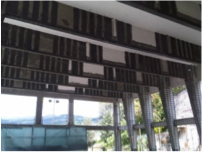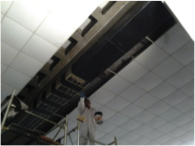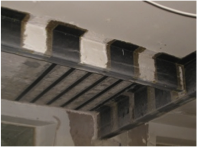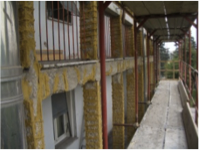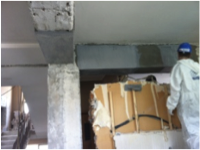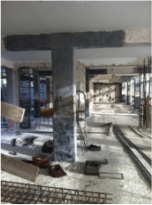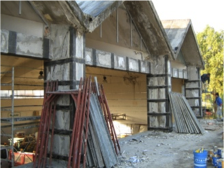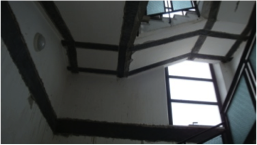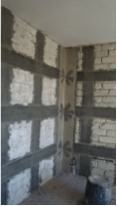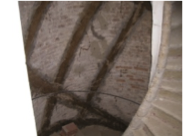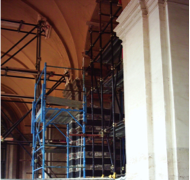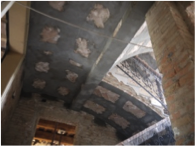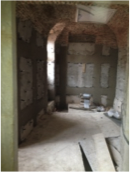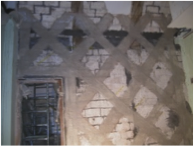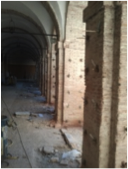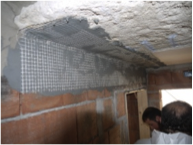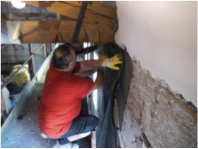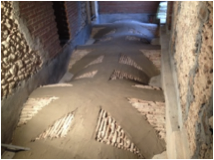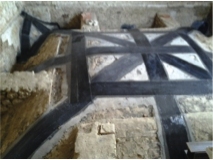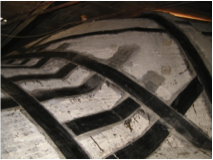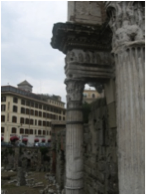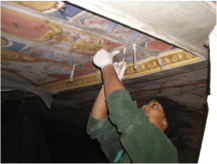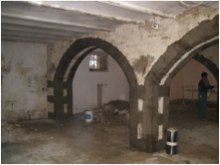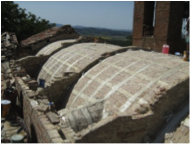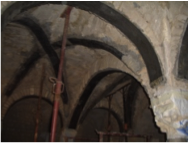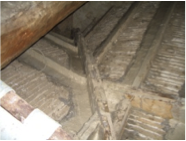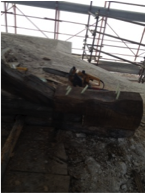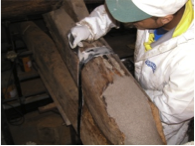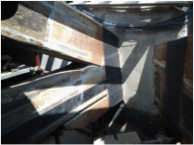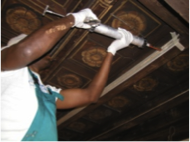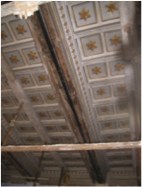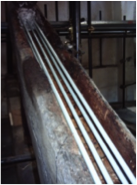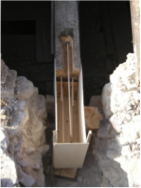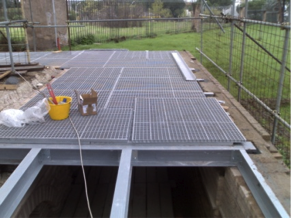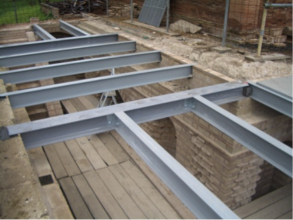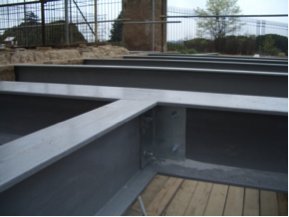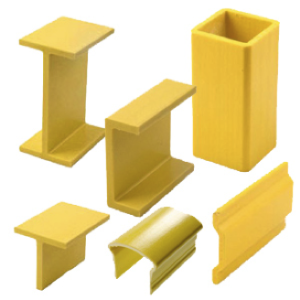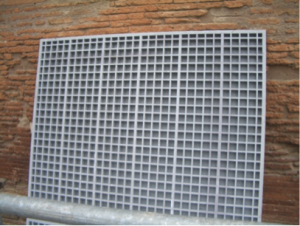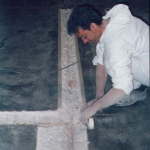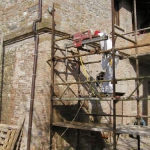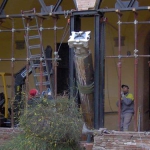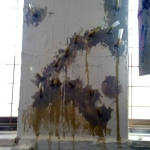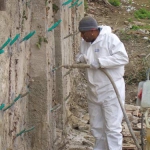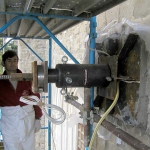Materials and new consolidation and sanitation methods
The systems and the materials that Edilsystem uses are the most innovative and advanced on the market, such as carbon fibers, glass fibers, aramid fibers, basalt fibers, flax fibers, hemp fibers, in steel fiber fabrics, to be used mainly in the following fields:
-
Seismic improvement
-
Seismic upgrading
-
Safety measures for buildings affected by earthquakes
-
Overload increase
-
Restoring corroded armor
-
Adaptation requirement regulations
-
Design mistakes
-
Executive
Seismic improvement
The seismic improvement interventions are aimed at reducing the deficiencies of a design that did not foresee the current seismic and or static loads considered inferior to existing ones.
The designer with the safety assessment will determine the maximum size of the seismic action under the Technical Standards for Buildings in which the property in question will be able to resist, identifying the elements where the resistant ability (or strain) is lower than the corresponding request.
When calculating you will have to assess how to intervene, using the latest materials such as FRP to achieve:
- increased deformation capacity of the structure;
- increased flexibility and capacity resistant to bending and cutting of the pillars;
- increased resistance to bending and/or cutting of beams, and/or tiled
Seismic upgrading
In case of seismic retrofitting it is necessary to evaluate the safety and, if necessary, the adaptation of the building, to those who want:
- raise the construction/expand the construction with the use of structurally works attached to the building;
- make class changes and / or destination of use which involve increases in global foundation loads more than of 10%;
- undertake structural measures aimed at transforming the building through a systematic set of works that lead to a different building structure from the previous one.
The Decree called “Decreto del Fare” (Decree Law 63/2013) gives the possibility to have a deduction of 65% for seismic upgrading of buildings intended for production activities or domestic if they are located in seismic zone classification 1 or 2.
With “CARBOSYSTEM” you can intervene in these cases:
Consolidation of reinforced concrete structures
- Restoration of the carrying capacity of structural elements, due to the deteroration or corrosion of the reinforcement rods.
- Flexure and shear reinforcement of exposed and thickness reinforced concrete beams.
- Reinstatement of the structural function of insufficient or degraded brackets.
- Encircling for the reinforcement of any dimension and shape pillars
- Increase resistance to compression of the concrete in the pillars.
- Reinforcement of reinforced concrete floors for unexpected load increases.
- Structural connections of the beam-column joints.
- Floor stiffeners of reinforced concrete slabs with connection to the vertical structure.
- Restoration of the carrying capacity of structural elements damaged by fire, shock and infiltration.
- Change of intended use of the building where it is necessary to increase the bearing capacity of beams, columns and slabs.
Fflexural and shear reinforcements of masonry structures
- Recovery and/or increase the bearing capacity of the wall panels.
- Reinforcement of columns and brick pillars of any shape.
- Structural connections between masonry and reinforced concrete structure.
- External or internal containment cerclage of masonry structures.
- Structural consolidation of uneven walls, damaged or corrupted.
- Restoring the structural continuity between horizontal or curved elements and vertical elements.
- Creating curbs for containment slab floor.
Strengthening of vaulted structures, domes, arches
- Consolidation of barrel vaults, groin vaults, cloister vaults, sometimes mixed.
- Consolidation of round arches, low arches, flying buttresses, pointed arch, or elliptical arcs.
- Consolidation of “camorcanna” archways and archways in rods.
All types of intervention of vaulted structures can be performed either intrados that extrados, due to the possibilities of access
Wooden structures reinforcement
Structural reinforcements can be carried out in two different ways: by applying pultruded doffs in carbon-fiber sheets or by entering fiberglass structural profiles, obtained from hot pultruding processes (resin bath) of thermosetting resins.
The use of FRP (fiber reinforced plastic) is very suitable for primary/secondary beam bending reinforcements, also because:
- they reduce deformations
- they increase the load-bearing capacity and resistance to fatigue
- we can calculate the reinforcement needed according to the required performance
- working time reduction
- lightweight intervention without increasing permanent loads
Use of composites in construction
Composite materials are an effective method for reinforcement and restoration of civil engineering works. They consist of a reinforcement of fibers with high mechanical properties and an epoxy or cement matrix, which ensures the adherence of the fabric plates to the support and therefore the load transfer.
The issue of new regulations by the CNR (National Council for Research), as DT200/2004, DT201/2005, DT202/2005 and subsequent amendments to the application of composites in construction, has been a turning point in the application of carbon and glass fibers, when restoration and reinforcement works of bearing damaged structures (civil, industrial and monumental construction) are concerned.
Reinforcements are applied for direct lamination on the surface to be reinforced by using epoxy resin matrices and more recently by cement mortar or lime-based systems.
The good quality of these systems is guaranteed by: good knowledge of the fiber-matrix interactions, adherence phenomena at the interface, and testing and subsequent verification.
Edilsystem offers a complete range of products for structural reinforcement; all the resins, mortars and fibers used are certified and subject to internal and ministerial laboratories quality controls.
- GLASS FIBERS
Glass fibers are cheaper than carbon fibers, but have much lower mechanical properties as well as a higher deformability and resistance to compression. - CARBON FIBERS
They have high mechanical properties and a high chemical resistance compare to others, as well as a guarantee and an infinite durability and are divided into: high and very high elastic modulus, unidirectional or bidirectional, quadraxial, etc. - ARAMID FIBERS
These fibers belong to the category of “aromatic polyamides” and have high mechanical properties and a great vibrational energy dissipation capacity.
They have a lowest density compared to glass and carbon fibers, but show greater absorption of water, lower resistance to PH variations and greater resistance to radiation, in particular UV. Furthermore, at constant load, Aramid fibers can show sensible “creep” phenomena. - STEEL FIBERS
Steel fibers are formed by micro galvanized steel strands at very high resistance, and fixed on a micro-grid glass fiber that facilitates the installation steps. They are present in the market as easily adaptable and workable unidirectional sheets. The galvanized steel fiber sheets provide unique structural and mechanical properties, much higher than conventional glass, carbon and aramid fiber sheets; they are very effective in structural reinforcement and seismic improvement as well as in the realization of plating connection systems, in combination with injector&connector.These are tensile fibers used in structural reinforcements by special mechanical anchoring systems thanks to the particular characteristics of the sheet; the fibers do not require the prior impregnation of the mats and at the same time allow anchoring and gripping through metal plates without resorting to any special requirements, as it happens with all other types of fibers and fabrics on the market.
They can be shaped with a special folding machine that easily models the fabric without altering mechanical properties; this method is also used in the execution of brackets for pillars and beam banding and fissures in structural consolidation works.
- Pultruded and laminated reinforcements
Carbon fiber pultruded plates/foils can be produced in different lengths and thicknesses and using high tenacity carbon fibers (HT) or high modulus type (HM). As they are not deformable and they cannot blend, can be also used in perfectly straight structures, as beams and concrete structures.
These fibers are obtained by vacuum process techniques; they are only produced by request of the designer, when they are necessary particular characteristics not obtainable with the standard pultrusion processes are required.
Carbon, grass or aramid fiber pultruded bars are produced with different diameters and lengths. Continuous carbon fiber roll bars are produced with diameters of less than 8 mm. Bars are widely used as connectors, strands and connections for concrete structures and in masonry. - Pultruded structural profiles
Pultruded profiles are elements of composite material obtained with pultrusion techniques. They are composed of organic synthetic resins, in general glass fiber.
Pultruded profiles in glass fiber consist of long fiber and sheets and are also known as: FRP (Fiber Reinforced Polymers) or GRFP (Glass Fiber Reinforced Polymer) in the case of glass fibers and CF (Carbon Fiber) in the case of carbon fibers.
Glass fiber pultruded profiles are preferred to conventional steel and aluminum profiles for the following reasons:
- Lightness
- High corrosion resistance
- Dielectric properties
- Thermal insulation
The polyester resins composite materials are indeed around 70% lighter than steel, they are also resistant to weathering corrosion and immune to electromagnetism.
These are also some advantages of pultruded profiles consisting of organic resins:
- Low thermal conductivity
- Thermal Stress resistance and expansion
- Excellent bump resistance
- Excellent mechanical resistance
Use of composite materials is highly recommended specially in civil/industrial construction world, where we find problems as corrosion and electromagnetic interferences. It should also be noted that structural pultruded profiles allow substantial savings in terms of time and cost in the assembly phase and maintenance.
The solution of problems related to building restoration, consolidation and concrete structures refurbishment of cultural heritage and modern buildings requires the expertise in highly specialized techniques for the continuous introduction of either materials into traditional interventions or new but tested technologies.
Below are some of consolidation and refurbishment techniques and materials used:
GROUT
The solution of problems related to building restoration, consolidation and concrete structures refurbishment of cultural heritage and modern buildings requires the expertise in highly specialized techniques for the continuous introduction of either materials into traditional interventions or new but tested technologies.
Armed and non armed perforation
Attaching steel bars to anchor bracing and keys, etc. can be made by substitution of traditional cement. Reinforced and non reinforced concrete drilling use intensively expansive pourable or injectable mortars, based on hydraulic binders with low salt content and formulated epoxies; as long as cracking of stone blocks, mortar or concrete nature require it.
Epoxy composites injections
Epoxy products in control fluidity are widely used in case of crackings which causes had been identified and removed. These products are injected to form a structural continuity. Piloted injections in walls, arches, vaults, pillars and other structures allow to obtain excellent results.
Masonry and plaster consolidation through pozzolanic lime or grout mortar injections.
Filling of voids, gaps and cavities also in the presence of sulfates. Adapted for the consolidation of stone, bricks and tuff walls by filling the cracks through injection. Also adapted for the detached and cracked plaster consolidation and sealing of damages, so as to recover the original static system without alterations or forcing of the loads and geometry that guarantee the correct static operation of the building.
Cortical consolidation and stone face protection
In the light of the most established theories of restoration, this intervention is carried out using similar materials to those to be restored, by impregnation with silicon based materials whose function is to weld the cracks by filling them. Protection is done with breathable and non-filmogeneous siloxane waterproofing materials.

